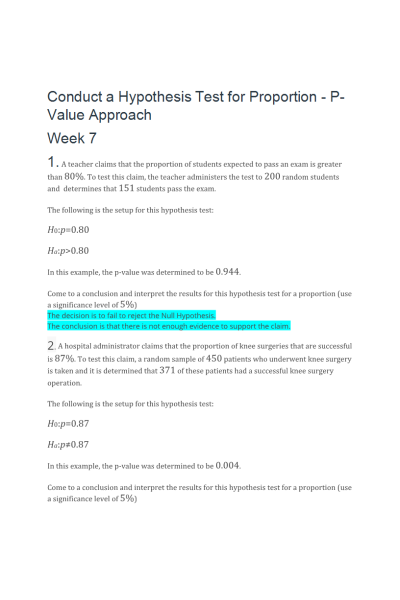MATH 225N Week 7 Assignment; Conduct a Hypothesis Test for Proportion; P-Value Approach
-
$25.00
| Institution | MATH 225N Statistical Reasoning for the Health Sciences |
| Contributor | Brianna |
- Question: A teacher claims that the proportion of students expected to pass an exam is greater than 80%. To test this claim, the teacher administers the test to 200 random students and determines that 151 students pass the exam.
- Question: A hospital administrator claims that the proportion of knee surgeries that are successful is 87%. To test this claim, a random sample of 450 patients who underwent knee surgery is taken and it is determined that 371 of these patients had a successful knee surgery operation.
- Question: A college administrator claims that the proportion of students that are nursing majors is greater than 40%. To test this claim, a group of 400 students are randomly selected and its determined that 190 are nursing majors.
- Question: A police officer claims that the proportion of accidents that occur in the daytime (versus nighttime) at a certain intersection is 35%. To test this claim, a random sample of 500 accidents at this intersection was examined from police records it is determined that 156 accidents occurred in the daytime.
- Question: A teacher claims that the proportion of students expected to pass an exam is greater than 80%. To test this claim, the teacher administers the test to 200 random students and determines that 151 students pass the exam.
Find the p-value for this hypothesis test for a proportion and round your answer to 3 decimal places.
- Question: A human resources representative claims that the proportion of employees earning more than $50,000 is less than 40%. To test this claim, a random sample of 700 employees is taken and 305 employees are determined to earn more than $50,000.
Find the p-value for this hypothesis test for a proportion and round your answer to 3 decimal places.
- Question: A college administrator claims that the proportion of students that are nursing majors is less than 40%. To test this claim, a group of 400 students are randomly selected and its determined that 149 are nursing majors.
- Question: A business owner claims that the proportion of online orders is greater than 75%. To test this claim, the owner checks the next 1,000 orders and determines that 745 orders are online orders.
- Question: A human resources representative claims that the proportion of employees earning more than $50,000 is less than 40%. To test this claim, a random sample of 700 employees is taken and 305 employees are determined to earn more than $50,000.
- Question: A local cable company claims that the proportion of people who have Internet access is less than 63%. To test this claim, a random sample of 800 people is taken and its determined that 478 people have Internet access.
- Question: A college administrator claims that the proportion of students that are nursing majors is less than 40%. To test this claim, a group of 400 students are randomly selected and its determined that 149 are nursing majors.
- Question: A researcher claims that the proportion of people who are right-handed is 70%. To test this claim, a random sample of 600 people is taken and its determined that 397 people are right handed.
- Question: A college administrator claims that the proportion of students that are female is 62%. To test this claim, a random sample of 300 students is taken and its determined that 211 students are female.
- Question: A researcher is investigating a government claim that the unemployment rate is less than 5%. To test this claim, a random sample of 1500 people is taken and its determined that 61 people are unemployed.
Find the p-value for this hypothesis test for a proportion and round your answer to 3 decimal places.
- Question: A business owner claims that the proportion of take out orders is greater than 25%. To test this claim, the owner checks the next 250 orders and determines that 60 orders are take out orders.
Find the p-value for this hypothesis test for a proportion and round your answer to 3 decimal places.
- Question: An economist claims that the proportion of people who plan to purchase a fully electric vehicle as their next car is greater than 65%.
To test this claim, a random sample of 750 people are asked if they plan to purchase a fully electric vehicle as their next car Of these 750 people, 513 indicate that they do plan to purchase an electric vehicle.
Find the p-value for this hypothesis test for a proportion and round your answer to 3 decimal places.
- Question: A researcher claims that the proportion of college students who plan to participate in community service after graduation is greater than 35%. To test this claim, a survey asked 500 randomly selected college students if they planned to perform community service after graduation. Of those students, 195 indicated they planned to perform community service.
- Question: A police office claims that the proportion of people wearing seat belts is less than 65%. To test this claim, a random sample of 200 drivers is taken and its determined that 126 people are wearing seat belts.
- Question: A police officer claims that the proportion of accidents that occur in the daytime (versus nighttime) at a certain intersection is 35%. To test this claim, a random sample of 500 accidents at this intersection was examined from police records it is determined that 156 accidents occurred in the daytime
| Instituition / Term | |
| Term | Summer 2020 |
| Institution | MATH 225N Statistical Reasoning for the Health Sciences |
| Contributor | Brianna |
















